#craven commercialism
Explore tagged Tumblr posts
Text

It's not too late: head to your favourite bookstore to grab Effin' Birds playing cards, postcards, calendars and books for under the tree.
#shitmas#craven commercialism#birds#swearing#illustration#nature#comics#bird#funny#vulgarity#art#comic#i gotta eat
867 notes
·
View notes
Text
Actually, most stuff *isn’t* political; you are just insane

Over the last several years, what was once a niche academic observation has become something of a mantra in left-liberal spaces: everything is political. (Everything is ideological doesn’t quite mean the same thing, but in effect the two assertions are interchangable).
There’s a grain of truth here, as anyone who smoked pot in high school and just, like, had some really deep thoughts will confirm. In order to understand any statement or work of art--in order to communicate--there must exist some shared understandings and beliefs between senders and receivers. Okay, great. Whoopdee doo. That’s some real philosophy major-level shit. You should write a fucking book about.
In spite of being unbearably tedious, this observation has become an all-consuming basal assumption underlying every left-liberal analysis of social issues and criticism of cultural artifacts. No longer are artists and commentators allowed to insist that some things simply fall outside the lens of our manichean partisan binary. No sir. Anyone whose work isn’t explicitly progressive is actually a secret reactionary, and so every work--from sitcoms to video games to journalistic descriptions of city hall meetings--must soak itself in the treacle of cultural liberalism.
If you’re writing a scene in which a black guy and a white guy are friends, you better fucking include a soliloquy in which privilege is reflected upon. If you’re making a breakfast cereal commercial that doesn’t feature at least one person of every conceivable racial marking, you might as well sign up for a job with the Daily Caller. Anyone who tries suggesting that, hey, I’m sorry I didn’t think it was a big deal that we didn’t make the Honey Nut Cheerio’s Bee gender non-conforming, I swear to god I didn’t think this was political is an idiot liar who deserves something far worse than prison. Why? Because everything is political, politics can only be understood within the contemporary Democrat-Republican split, and fascism happens the second our vigilance falters in the slightest.
You all see how retarded this is, right? How much it’s ruining people’s brains? At the very least, you can grasp how this hampers one’s ability to just enjoy stuff, let alone be able to understand its artistic and cultural importance outside the very narrow and stupid and 99% inapplicable lens of contemporary American politics?
I’m sorry, but I’m tried of lying about this shit. There’s nothing political about Kramer storming into Jerry’s apartment. There’s nothing political about Charlie Kelly blowing cigarette smoke into a hornet’s nest. There’s nothing political about the Pink Panther’s appearance in Owens Corning Insulation commercials.
Yes, you can get a byline or a humanities degree suggesting otherwise, so long as you’re craven enough to ignore context and authorial intent and also you think comprehensibility is bad. Again, good for you. But the rest of us, we are not professional lying shitheads, we have lost patience with the bullshit and are begging you to please shut the fuck up.
587 notes
·
View notes
Note
SCREAM 2 OPINIONS GO🔪🔪🔫🔫
Ok so I actually really like scream 2, I think it exists well within the spirit of what a scream movie should be in that it interacts with a horror sequel in the same way that Scream 1 interacts with slasher movies(and to be fair, other horror) generally.
Sidney is literally bored with Ghostface, and we see that in her first on screen appearance. It's a pretty simple scene but I think it does a good job of conveying some information about where Sid's at in life. Because now when she gets a call from ghostface it's nothing she hasn't dealt with before, she had caller I.D now. It's suggested that she's been getting prank calls from "ghostface" for a while now and she's over it. I like that for her. It's a nice evolution for a final girl, and the movie communicates it well in one scene.
She also has a cute little bob now so points for that. Very sapphic.
We also have the fact that the Woodsboro massacre has been commodified and is being made into a movie a mere 2 years after it happened. Gale is partly to blame for that but it still feels wild, especially because the tone of Stab isn't very serious, it's very much a blockbuster horror movie and not a crime-drama even though it's based on what is in universe a true crime case.
Director Wes Craven doesn't believe violence on film should be toned down and made comfortable for a general audience, so I kind of read the in-universe presence of the Stab franchise as Scream 2 making a comment on the way that real tragedies get re-packaged and sold as stories.
We also have Mickey and Nancy's kill list- it's a hollow replication of the murders in the first movie, and I don't mean that scream 2 does a bad job with them I mean that Mickey and Nancy kind of do. How do they pick their victims? Aside from the core group of people close to Sidney they're basically just random people with the right names.
Maureen Evans, Phil Stevens, and Casey "Cici" Cooper.
These victims have no personal connection to the killers or to Sidney for the most part, they're literally just there to be bodies. In contrast Billy and Stu had a personal, petty little kill list, all people that pissed them off or got in thier way somehow. Again, this feels like it fits in with the theme of commercialism, sequels bet on hitting the same notes as the original, but often fail to provide the same kind of motivation and backing.
(The only victim without that kind of connection in the original is Himbry and that’s explained by the fact that his death wasn’t in the original script, it was added in because executives thought the movie needed another kill since there’s so much space between the Casey and Steve murders and everything that happens at the party. So again, a product of commercialism.)
But I think the lack of connection Nancy and Mickey have with their victims is also commentary on the horror sequel, particularly with slasher movies where most of the cast died in the original. Sequels have a tendency to just throw a new cast at you without spending the same time and care developing them, they’re just designed to fit the same archetypes as the original (Mickey=Stu, Derek=Billy, Hallie=Tatum). Studios bank on the fact that you liked it the first time, so you’ll like it again if they check the same boxes.
Scream 2 doesn’t give us hollow copies though, and that’s what makes it a good movie, these replacements are designed for the most part as comments on the original. I think the best example here is Derek, who does actually fit the archetype Billy was pretending to be (popular, charismatic, outgoing) but he still doesn’t actually understand Sid or her trauma, which is where he parallels Billy the most. He just isnt trying to manipulate Sid like Billy was.
I also think the relationship between the killers works well with the theme of commercialism in sequels. The original killers are almost defined by their relationship to each other. Like, Stu does what he does purely out of his attachment to Billy. Billy and Nancy are both motivated by revenge and familial love, which is a theme through many of the other scream movies.
But Mickey isn’t motivated out of his attachment to Nancy, he has a financial motive. She’s literally bankrolling him, and he’s looking for fame. If we’re thinking cynically about horror sequels they are motivated by financial gain, relying on the success of the original to get people to buy in. Just like Mickey.
And in general the sequel just pushes so much over the top, with the first kill happening in the middle of the theater being perceived as a publicity stunt, to Randy being killed out in the open in broad daylight. It’s the classic sequel thing that all of the scream movies comment on- you need to raise the stakes.
Honestly there’s probably more I could say but I’ve already written an essay 🙃 yeah. I like scream 2. Good movie.
36 notes
·
View notes
Text
"Moreover, by the time Findlay switched her attention to horror, a number of her contemporaries were doing very well from the genre.
Wes Craven, a fully fledged horror auteur by the 1980s, had worked on numerous hardcore features around the time he directed The Last House on the Left in 1972, a widely controversial, yet popular horror film that played all over the world. The success of his subsequent horror films, including The Hills Have Eyes (1977) and especially A Nightmare on Elm Street (1984), showed that the transition from porn to horror was not only possible, but also potentially highly lucrative. Similarly, fellow New Yorker William Lustig cut his teeth directing two hardcore features, Hot Honey and The Violation of Claudia (both 1977), prior to shooting the horror film that made his name, Maniac (1980), and several higher-profile R-rated horror films he made in the years that followed.
As hardcore stalwart and director of the R-rated horror film, Deranged (1987), Chuck Vincent, explained to Variety, “Filming adult features has been a tremendous aid for me [and others] in terms of experience,” affording him and his contemporaries the ability to master industry-standard equipment and materials, such as 35mm film, and providing others, including adult film producer and producer of the horror film A Hazing Hell (dir. Paul Ziller, released as Pledge Night in 1988), Joyce Snyder, with unmatched knowledge of distribution and foreign sales.
Findlay, with the assistance of her partner, the composer and studio engineer Walter E. Sear, and their new company Reeltime Distributing (est. 1979), was well positioned to enter commercial filmmaking of this nature, by self-financing and shooting on location (as was usually the case with her adult features), and then exploiting her networks within theatrical, cable, and video distribution."
Johnny Walker, from ReFocus: The Films of Roberta Findlay (2023)
#roberta findlay#johnny walker#refocus: the films of roberta findlay#w*#w#some horror fans need to learn their herstory
55 notes
·
View notes
Text
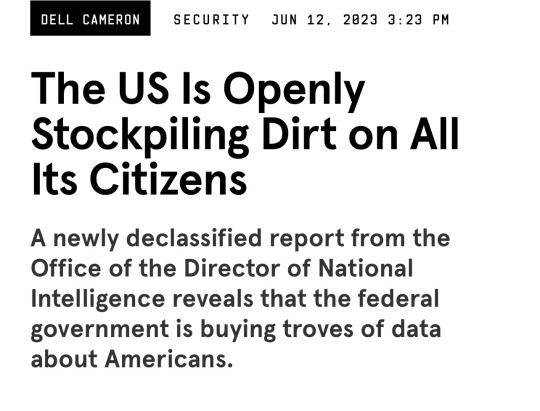
THE UNITED STATES government has been secretly amassing a “large amount” of “sensitive and intimate information” on its own citizens, a group of senior advisers informed Avril Haines, the director of national intelligence, more than a year ago.
The size and scope of the government effort to accumulate data revealing the minute details of Americans' lives are described soberly and at length by the director's own panel of experts in a newly declassified report. Haines had first tasked her advisers in late 2021 with untangling a web of secretive business arrangements between commercial data brokers and US intelligence community members.
What that report ended up saying constitutes a nightmare scenario for privacy defenders.
“This report reveals what we feared most,” says Sean Vitka, a policy attorney at the nonprofit Demand Progress. “Intelligence agencies are flouting the law and buying information about Americans that Congress and the Supreme Court have made clear the government should not have.”
In the shadow of years of inaction by the US Congress on comprehensive privacy reform, a surveillance state has been quietly growing in the legal system's cracks. Little deference is paid by prosecutors to the purpose or intent behind limits traditionally imposed on domestic surveillance activities. More craven interpretations of aging laws are widely used to ignore them. As the framework guarding what privacy Americans do have grows increasingly frail, opportunities abound to split hairs in court over whether such rights are even enjoyed by our digital counterparts.
“I’ve been warning for years that if using a credit card to buy an American’s personal information voids their Fourth Amendment rights, then traditional checks and balances for government surveillance will crumble,” Ron Wyden, a US senator from Oregon, says.
(continue reading)
#politics#police state#mass surveillance#privacy rights#surveillance state#data mining#4th amendment#4th amendment rights
90 notes
·
View notes
Text
since it’s october and people like to get into spooky movies let me recommend a little werewolf movie titled “Cursed” (2005) which stars Christina Ricci, Jesse Eisenberg and others (Milo Ventimiglia, Mya, Joshua Jackson, Judy Fucking Greer et. al.) - it has a troubled production history and was a flop all round (Craven hated the final commercial cut) but it’s one of the funniest horror movies i’ve ever seen. it’s such a wild ride. definitely give it a go if you like werewolfy stuff and true camp.
3 notes
·
View notes
Text
Top 10 horror movies from the 90's

The 1990s produced a diverse array of horror films that left a significant mark on the genre. Below are ten notable horror movies from that decade, showcasing various styles and themes.
The Silence of the Lambs (1991)
This psychological horror film directed by Jonathan Demme is often cited as one of the best films of all time. It follows FBI trainee Clarice Starling as she seeks the help of incarcerated cannibalistic serial killer Dr. Hannibal Lecter to catch another killer, known as "Buffalo Bill." The film won five Academy Awards, including Best Picture, and is renowned for its intense performances and psychological depth.
Scream (1996)
Directed by Wes Craven, Scream revitalized the slasher genre with its self-aware humor and meta-commentary on horror film tropes. The story revolves around a group of teenagers being stalked by a masked killer known as Ghostface. Its success led to multiple sequels and established a new wave of slasher films that embraced humor alongside horror.
Misery (1990)
Based on Stephen King's novel, Misery tells the story of an author who is held captive by his "number one fan" after a car accident. Directed by Rob Reiner, the film features a chilling performance by Kathy Bates, who won an Academy Award for her role. The film's exploration of obsession and captivity resonates powerfully with audiences.
The Blair Witch Project (1999)
This groundbreaking found-footage horror film follows three filmmakers who become lost in the woods while investigating a local legend. Its innovative marketing campaign and realistic portrayal of terror made it a cultural phenomenon, influencing many subsequent horror films. The film's minimalistic approach to horror, relying on atmosphere and suggestion rather than special effects, set a new standard for the genre.
5. Candyman (1992)
Directed by Bernard Rose and based on Clive Barker's short story, Candyman explores urban legends and racial themes through the story of a graduate student who summons a vengeful spirit by saying his name five times in front of a mirror. The film is noted for its social commentary and haunting atmosphere, becoming a cult classic.
Jacob's Ladder (1990)
This psychological horror film directed by Adrian Lyne follows a Vietnam War veteran who experiences disturbing hallucinations as he tries to uncover the truth about his experiences in the war. The film is known for its surreal imagery and exploration of trauma, making it a unique entry in the horror genre.
Tremors (1990)
A blend of horror and comedy, Tremors features a small town besieged by giant underground creatures known as Graboids. The film, starring Kevin Bacon and Fred Ward, became a cult favorite for its humor, practical effects, and engaging characters, leading to several sequels and a television series.
The Sixth Sense (1999)
This supernatural thriller directed by M. Night Shyamalan follows a young boy who can see and communicate with the dead. The film is famous for its twist ending and emotional depth, earning critical acclaim and commercial success. It solidified Shyamalan's reputation as a master of suspense.
Night of the Living Dead (1990)
This remake of George A. Romero's classic zombie film retains the original's themes of survival and societal breakdown. Directed by Tom Savini, the film updates the special effects while maintaining the intense atmosphere that made the original a landmark in horror cinema.
Audition (1999)
Directed by Takashi Miike, Audition starts as a romantic drama before transforming into a horrifying tale of obsession and revenge. Known for its shocking violence and psychological depth, the film has gained a reputation as a modern classic in horror cinema, pushing boundaries and challenging audiences.
These films collectively illustrate the evolution of horror in the 1990s, highlighting the decade's experimentation with narrative styles, themes, and subgenres.
5 notes
·
View notes
Note
Re baiting anon: Gaylors most of them are vile towards Karlie. If she wasn't with Taylor posting anything alluding to her would be self sabotage. Karlie also flags some things BEFORE Taylor does it & sure once you could say she had an "insider" but Taylor would cut that shit out after the 1st time. Yet she didn't. Also the entire Eras Tour is basically a tribute to Karlie. Almost every set copies something Karlie has done in the past, a cat walk, a commercial, a music video etc or something special to Karlie and Taylor. Many visuals for albums are also linked to her. For example the new photo shoot for 1989, it was basically a copy of an older Karlie photo shoot. So unless people want to put forwards the argument that Karlie forces Taylor to do these things then idk...
yeah i almost want to do a twinning/koincidence walkthrough that involves creative project because like you said there are several times where it’s more than just wearing similar clothes but something where karlie goes first and taylor goes next and then karlie goes again, or taylor goes first and karlie goes next and karlie goes again and basically what it shows is that if they both hated each others guts, either one of them would not follow through at some point. so it sort of burns the bridge of that line of thinking. then people have to go to the “they’re both craven and toxic and greedy and desperate” route and it always comes off forced, to me 😌
13 notes
·
View notes
Text
Michael Serazio at Vox:
For most of advertising history, “red” or “blue” as partisan loyalty signaled more your taste for Coke or Pepsi than your identity as Republican or Democrat. Mass markets, by definition, necessitated selling to both sides of the aisle. As with so much else, the presidency of Donald Trump — built upon a self-conceived human brand — radically upended those norms. Post-2016 election, one Adweek column thundered, “Brands cannot expect to play Switzerland as the rest of the world picks a side.” Consumer culture suddenly became the vehicle for political expression, with Madison Avenue giving voice to countless causes. The staid “corporate social responsibility” morphed into the more muscular “brand purpose,” which beget impassioned activism. Social justice became “trendy;” politics, the means to signal commercial “integrity.”
Today, just as during the Trump presidency, controversial issues abound, protesters convulse public spaces, and a divisive election looms. The world is picking sides — on abortion and Gaza and Trump’s trials. And from brand-land? By and large, the sound of silence. That’s because, despite prior pretense, advertising follows, not leads; it needs markets, not morality. That silence, therefore, says much about our sociopolitical moment: As culture warriors find themselves on the defensive, brands, wary from the backlash against Bud Light’s use of a trans influencer, no longer show interest in advancing their causes. Indeed, today’s primary “cause” — and, arguably, election issue — is lower on the hierarchy of needs: cost of living. That makes for a more practical, less symbolic battleground for commercial content. In 2024, whatever else might happen, the revolution will not be advertised.
During the Trump years, advertising evolved a bit like journalism: It went from ostensible objectivity and pitching its product across allegiances to satisfying partisan preferences and selling to niches. As society polarized and fragmented and everything got politicized — the NFL, safety pins, low-flow toilets — neutrality came across as craven delusion.
This fundamentally shifted the logic and basis of consumer choice. Previously, we thought, “If I’m going to buy paper towels, are they useful? Are they inexpensive?” one marketing executive explained to me. By 2020, “societal issues [had] become brand attributes ... in terms of product purchases.” The question became: How “woke” are your paper towels? If the ads of the 2010s felt like they were talking back to Trump, you're not mistaken. Like other domains of cultural production — journalism, the popular arts, academia — brand-land leans left. For many such news topics invoked commercially — race, guns, the environment — creative professionals couldn’t conceive of there being “two sides” to the story.
[...] Brand-land was arguably taking its cues from market demand: One poll found nearly three-quarters of consumers wanted retail companies to stand up for their political beliefs and another found two-thirds would switch from a brand if those didn’t align with their own. At times, those consumers themselves took the initiative on activism. Much like today’s protesters clamoring for Israel divestment, a #GrabYourWallet boycott of Trump-aligned products and companies went viral. The personal has, of course, long been political, but during the 45th presidency, the civic became commercial as never before. Then, just as quickly as it had stormed the barricades, Madison Avenue abandoned them.
[...] Again, commercial communication follows, not leads. Advertising’s activist retreat mirrors a reversal in public sentiment, perhaps a post-pandemic fatigue. One poll finds just 20 percent of Americans are now interested in corporations taking a stand on political issues or current events, and fewer than 30 percent want to hear brands opine on international conflict. Curiously, among the least supported issues (for brand engagement, at least) are many that defined the commercial battlegrounds of the Trump years: police reform, immigration, LGBTQ+ rights, and abortion.
[...]
Perhaps there’s another type of issue that’s more pressing to Americans right now, one that retail companies can uniquely speak to because, historically, that was their primary messaging domain: How much are we paying and for what? After all, rising prices are arguably the defining political issue of the Biden era. That doesn’t allow for sexy, flashy branding — or even the moral, culture war invocations of the Trump years — but it’s top of mind when you have to pay 15 bucks for a sandwich or salad at lunch. In turn, that assumed attentiveness to price and utility treats the consumer as pragmatic rather than performative: someone concerned for what a product costs and does rather than how it might reflect their sociopolitical identity. It also suggests that virtue-signal shopping is a luxury less affordable during inflationary times. Unstated by Pritchard but surely informing his caution is Bud Light’s reported billion-dollar sales slide, attributed to a transphobic boycott following a fleeting partnership with social media star Dylan Mulvaney in early 2023. When that backlash exploded, Anheuser-Busch’s CEO defensively walked back any pretense of activism: “We never intended to be part of a discussion that divides people."
There had, of course, been brand politics flops before. Starbucks nudged customers and baristas to, awkwardly, “Race Together” by striking up conversations about police-exonerated killings of Black men. Pepsi similarly pissed off the entire internet with its quasi-Black Lives Matter spot attaching the soda, visually and conceptually, to street protests in a way that’s unimaginable now, given the campus unrest of recent months. The Bud Light kerfuffle, though, had more of a financial and cultural impact on the brand because it represented a real mismatch of target audience and their perceived politics. Starbucks and Pepsi fans likely didn’t find anti-racist causes wrong, just the messaging heavy-handed and poorly executed. And post-Mulvaney, the influencer marketplace — an estimated $20 billion-plus industry — is increasingly scrutinized for risky content that might alienate one side or the other.
[...] Under Trump, brands had appointed themselves vessels for progress, most especially on matters of cultural identity like race, sex, and immigration. In the years since, corporations have backpedaled to more of that “Switzerland” neutrality, reflecting a broader retreat from DEI ambitions across both law and norms.
A trend that was dominant in the late 2010s and early 2020s, the “woke” capital movement that many brands had in their ace has begun to fall apart, owing to the ongoing inflation issue and the backlash over Dylan Mulvaney being in a single Bud Light ad.
4 notes
·
View notes
Text
The CEO of MakoMart (LLC) was named Trout Jehoshaphat Craven, and he almost deserved it.
Hosting Turf War matches in a supermarket was a rather off-the-wall business decision to begin with, but it payed back dividends in publicity, exposure, and — most importantly — that sweet, sweet slice of the profit pie. Now, the ground-level employees of MakoMart never saw much of said profit, but Trout reasoned to himself that, by virtue of his mere presence as a high-net-worth individual, it would all trickle down to them one way or another.
One evening, he had his most brilliant idea yet: a theme song! Not your standard commercial jingle; MakoMart already had several inoffensive tunes in that vein. Nay, this was to be a full-fledged battle anthem worthy of both the Turf War scene and MakoMart itself! If a bowling alley was able to squeeze a smash hit out of some worthless floozies from the boondocks (Deep Cut with "Smeared Canvas"), why, Trout J. Craven could commission an even better work of art for even less, couldn't he! Thrift and Grift were his two middle names! (if you discounted the one he already had, but tbf who wouldn't?)
So it's rather unlucky that, by happenstance, the indie band this CEO hired to compose an anthem for MakoMart were:
A.) fervent anti-capitalists B.) already in a collective, melodramatic affair with his wife.
The five-and-a-half minute power ballad that played over the intercoms that weekend made both these points very explicit.
(The lyricist is best known for his ill-fated collaboration with Pearl Houzuki on "#$@%* Dudes Be #$@%* Sleepin'", if that gives you a better picture.)
During the resulting scorched-earth legal klusterfuffle that continues to this very day, the rights to the "employee bonus" one-and-a-half-minute karaoke version (now playing) was inexplicably sold off to interested parties from Barnacle & Dime — who started sneaking it onto their Turf War playlist. While this karaoke version is but a shell of what it's supposed to have been, it's become one of those near-memetic songs where if you know, you know.
Eventually, life goes on, jokes are left behind, and this tune will comfortably fade into the grocery store background static that it probably should've been in the first place.
(sample source list can be found on my YouTube)
#splatoon#splatoon ost#fan music#fan ost#makomart#barnacle & dime#stage theme#fan splatband#splatband#grocery store lore#backstory#deep cut#smeared canvas#splatoon 3#arrangement#mashup#jean-jacques perrey#bossa nova#breakcore#musak#splatune 3#music#audio#going to the store#to buy cd-roms and weedkiller and you hear this over the intercom; what you do?
20 notes
·
View notes
Text
A Review/ Comparison of Texas Chainsaw Massacre (1974) and Chungking Express (1994)
By Jacob Christopher
Texas Chainsaw Massacre
Critiquing the decay of the American Dream and the horrors lurking beneath the surface of seemingly ordinary society. Tobe Hooper and his film Texas Chainsaw Massacre explores themes of madness, family dysfunction, and the brutality of human nature. For this week I decided to choose and view Texas Chainsaw Massacre along with a group of friends for a frightful festivity. Directed by Tobe Hooper, the film is considered a staple of the horror slasher genre, which creates a significant impact on both pop culture and the utilization of horror cinematography. With a reputation for it’s raw intensity and unique poster child of leather face, how could I not want to give the film a watch.
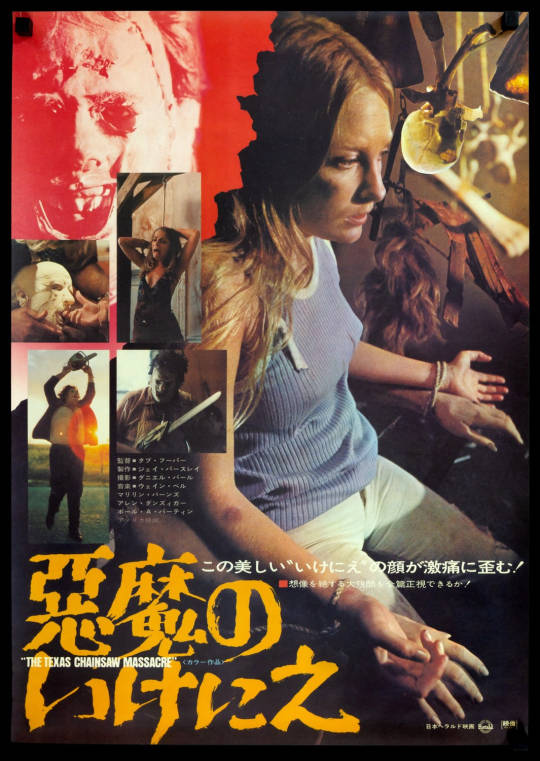
An original Japanese B2 poster of the Texas Chainsaw Massacre
A review and praise for Texas Chainsaw Massacre, emphasized through the appraisal of the film from respected directors such as Eli Roth and Wes Craven, even given the reputation the film has for it's gore and slasher terror. To this day the film garners positive reception for all its product as a pivotal piece of media within the horror genre.
The story follows a group of young friends who encounter a family of cannibals in rural Texas. Where the group becomes the target of Leatherface, a mentally disturbed member of the family of cannibals who wears a mask made of human skin and wields a chainsaw. As the friends are hunted down one by one, they face gruesome and terrifying encounters. This premise taps into primal fears of isolation, rural landscapes, and the unknown, making it deeply unsettling.
In 1974, nearing the end of the Vietnam War, the United States witnessed pivotal political upheavals, notably the resignation of U.S. President Richard Nixon in the wake of the Watergate scandal. Additionally, the sports realm saw significant moments such as The Rumble in the Jungle, a legendary boxing match between Muhammad Ali and George Foreman.
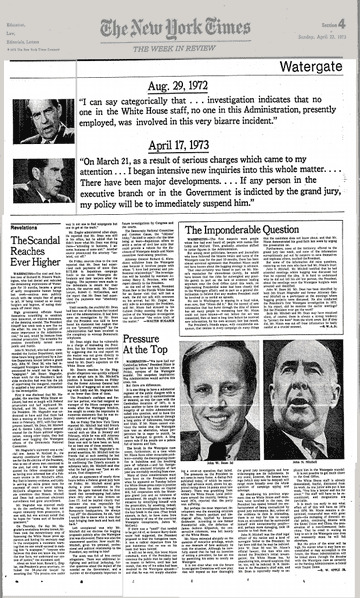
Archived article about Watergate
Giving context to the period of time, in 1974 the indie film movement was a significant period in cinema history. Characterized by a surge in independent filmmaking that challenged the dominance of the major studios. This movement emerged as a response to the increasingly commercialized and formulaic nature of Hollywood filmmaking, with filmmakers seeking greater creative freedom and the ability to explore unconventional subjects and storytelling techniques.
One of the key factors driving the indie film movement in 1974 was the availability of new and more affordable filmmaking technology, such as lightweight cameras and portable sound equipment. This allowed aspiring filmmakers to produce high-quality films on shoestring budgets, circumventing the need for studio backing
The low-budget filmmaking techniques utilized in Texas Chainsaw Massacre played a crucial role in shaping its distinctive direction and ultimately contributed to its enduring influence on the horror genre. With a restrictive budget of $140,000 USD, creative solutions to technical challenges were implemented. Director Tobe Hooper and his team embraced this constraint, opting for a raw and gritty aesthetic that added to the film's overall sense of realism and intensity. Proving the film to be successful in it’s accumulation of a $30,859,000 USD domestic profit, 220 times the budget of the film.
youtube
A video showing the outtakes of the film, giving insight to the process of capturing the shots in Texas Chainsaw Massacre
Chungking Express
Chungking Express by the great director Wong Kar-Wai, a film that defies traditional narrative conventions and captures the rhythms of urban life with unparalleled artistry and emotion. Through its kaleidoscopic lens, Chungking Express invites viewers on a transcendent journey of love, longing, and serendipity amidst the chaotic backdrop of the Hong Kong metropolis almost as another character in Wong Kar-Wai’s films.
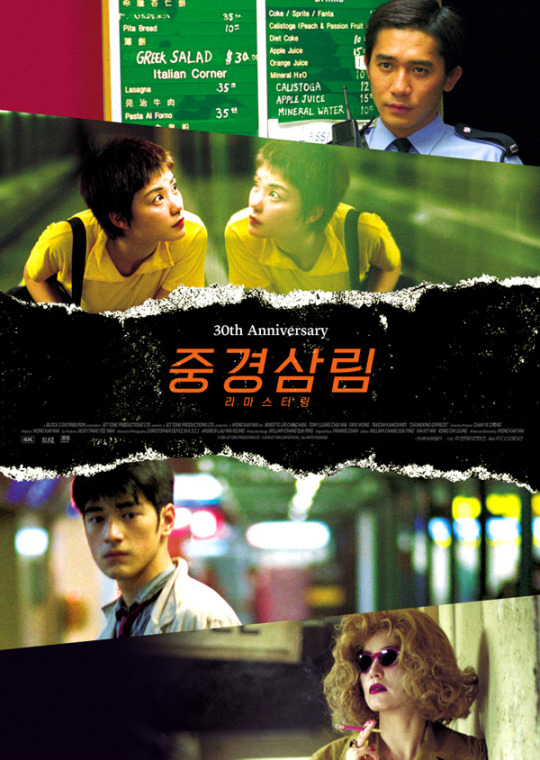
Chungking Express tells two separate but still interconnected stories of longing and love. In the first story we follow Cop 223, played by Takeshi Kaneshiro, coping with the recent breakup of his relationship. He frequents a local diner where he encounters a mysterious woman in a blonde wig, played by Brigitte Lin, who is involved in a drug smuggling operation. As Cop 223 becomes infatuated with her, he embarks on a series of eccentric rituals to cope with his heartbreak.
Adjacent to the second story, we meet Cop 663, played by Tony Leung, who is also dealing with the aftermath of a failed relationship. He develops a budding romance with Faye, a quirky waitress at the diner, played by Faye Wong. Faye secretly enters Cop 663's apartment, where she begins to rearrange his belongings and leave small tokens of affection, unbeknownst to him.
youtube
Above is a deleted scene between Cop 663 and Faye with commentary from Wong Kar-Wai. Excluding the scene of Cop 663's restlessness in my opinion creates more subtly for the characters angst.
As the two stories unfold, they intersect in subtle ways, with themes of chance encounters, missed connections, and the transient nature of human relationships permeating throughout. "Chungking Express" is a poetic exploration of love, loneliness, and the unpredictable nature of life in urban environments. Incorporating a sense of humor and poeticism often found within the films of Wong Kar-Wai.
youtube
Like the clip implies, this is also my favorite clip from the film. Expressing Cop 223's unacceptance of his past lover's moving.
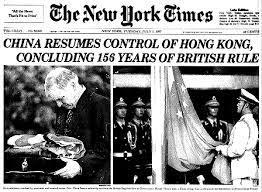
At the time of the film's release, Hong Kong was still a British colony, but the impending handover to China was looming on the horizon. The uncertainty and anxiety about the future of Hong Kong under Chinese rule permeated the collective consciousness of the city's residents. This sense of transition and flux is subtly reflected in the film's themes of impermanence and change.
youtube
Above is a in depth analysis and review from Tarantino about Chungking Express
Similarities Between the two films
Both films I've went over are incredibly different in tones, genre and style. There is more to contrast about the differences due to the vastly differing thematic content, however despite the juxtaposition, there are still similarities to be analyzed. Such as usage of space and area, seen through the sets of a rural Texas desert and the densely populated environment of Hong, both backdrops acting almost like a character within their own. Along with the unconventional qualities of story telling both films exude. Chungking Express' fragmented story structure and fun twist on narrative style gives the film an edge and hip odd feeling from the technique. In comparison, Texas Chainsaw Massacre also goes about it's narrative differently, creating a gritty, raw and realistic but dirty atmosphere, assisted through it's handheld camera style also found in Chungking Express. Giving the films a unique visual realness from it's creative choice.
3 notes
·
View notes
Text


Product sample day is my favourite day.
(You can get these in my shop right now)
#comics#funny#goose#geese#canada goose#canada geese#service animal#disservice animal#hat#cap#snapback#trucker hat#trucker cap#merch#craven commercialism#capitalism fucks up everything#please god don't let this unleash another week of Goose Discourse on me#birds#swearing#illustration#comic#vulgarity#cursing#bird#nature
319 notes
·
View notes
Text
DC v. Heller (SCOTUS) 2008 [excerpt]
Like most rights, the Second Amendment right is not unlimited. It is not a right to keep and carry any weapon whatsoever in any manner whatsoever and for whatever purpose: For example, concealed weapons prohibitions have been upheld under the Amendment or state analogues.
The Court’s opinion should not be taken to cast doubt on longstanding prohibitions on the possession of firearms by felons and the mentally ill, or laws forbidding the carrying of firearms in sensitive places such as schools and government buildings, or laws imposing conditions and qualifications on the commercial sale of arms.
Miller’s holding that the sorts of weapons protected are those “in common use at the time” finds support in the historical tradition of prohibiting the carrying of dangerous and unusual weapons. Emphasis added
So it wasn't until 2008 that a wrongly-decided case with the five conservative Justices affirming Heller that the possession of guns for the defense of 'hearth and home' was legalized.
The bizarre misconstrual of the Framers' intent with the 2nd Amendment reached its ultimate low point in 2022 with New York State Rifle & Pistol Association, Inc. v. Bruen, decided by the SCOTUS as prohibiting any restriction on 'concealed carry'.
It remains a mystery how the conservative Justices can divine the intentions of men who lived 250 years ago; the Justices who repealed the protections of Roe v. Wade also determined that since spousal abuse wasn't a recognized crime in 1775 it could not be grounds currently for prohibition of firearms possession. That appears to be the pinnacle of perverse logic bent to a specific result.
Is it any wonder that the once august Supreme Court is now held in lower esteem than used car salesmen? They have been revealed to be craven political operatives dancing to their organ grinder's music.
7 notes
·
View notes
Text




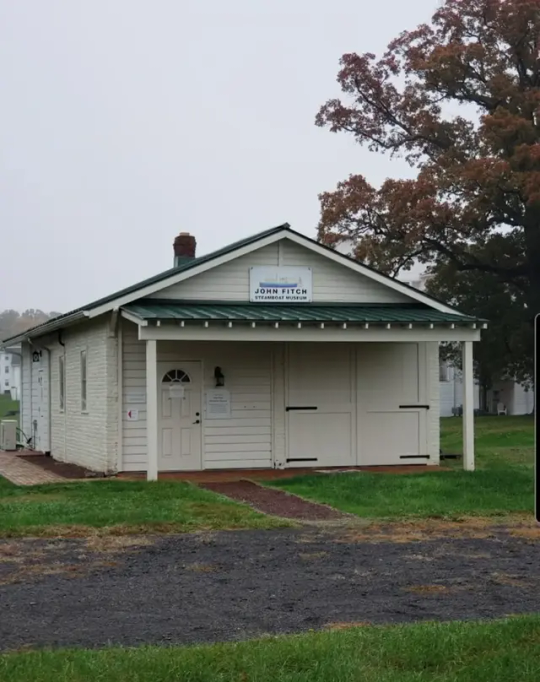
CRAVEN HALL
599 Newtown Rd, Warminster, PA 18974
Craven Hall a stately Federal/Greek revival home that was built between 1780 & 1845, with much of the building still original. Craven Hall is associated with families that were part of the American Revolution and prominent in local Pennsylvania history. The house was built for John Craven who was the founder of Johnsville, Pennsylvania. Later, the house passed down to members of the VanSant, Longstreth, Hart and Bennett families. Founded in 1977 as the Citizens for the Preservation of Craven Hall to save the building from demolition. Over its history, the house has been used as a home, multi-tenant dewelling, school and school administration offices. The name had been changed to the Craven Hall Historical Society, Inc. in 1993 when acquired from the then owner. This building serves as the headquarters for the Craven Hall Historical Society Inc. It was placed on the National Register of Historic Places in 2007. Sitting adjacent is a 1920s era carriage house/garage that houses the John Fitch Steamboat Museum dedicated to the world's first commercial steamboat inventor (1790).
A young Revolutionary War era soldier from the 1700s is believed to have been buried on the grounds of Craven Hall. He can be seen dressed in colonial style garb, through the windows of the first floor and frequently bangs on the windows at night as if he is trying to escape. Visitors interested in touring the facility are welcome at monthly open houses 2nd Sunday of the month from 12-3 PM, and special events throughout the year. You can also contact for private tours as well.
Have you ever visited & have you seen this young soldier? Would you visit at night & walk around to see if you see him too? Is the entity a soldier or is it something more sinister? If the walls could talk, what would they say?
#bucks county#themysterymaam#haunting#entity#haunted#colonial era#pennsylvania#paranormal#haunted house#scary#hauntedplaces#paranormallocations#ghostlyencounters
1 note
·
View note
Text
BEANSONBREAD AWARDS 2024 - BEST ALBUM
AWARD NO.2 - BEST ALBUM OF 2024

PAST WINNERS
2023 > Squid - 'O Monolith' (see full list HERE)
2022 > Jockstrap - ’ I Love You Jennifer B’ (see full list HERE)
2021 > Self Esteem - ‘Prioritise Pleasure’ (see full list HERE)
2020 > The Flaming Lips - ‘American Head��� (see full list HERE)
2019 > Self Esteem - ‘Compliments Please’ (see full list HERE)
2018 > Kero Kero Bonito - ‘Time ‘n’ Place’ (see full list HERE)
2017 > Richard Dawson - ‘Peasant’ (see full list HERE)
2016 > Blood Orange - ‘Freetown Sound’ (see full list HERE)
2015 > Holly Herndon - ‘Platform’ (see full list HERE)
2014 > FKA Twigs - ‘LP1′ (see full list HERE)
2013 > These New Puritans - ‘Field Of Reeds’ (see full list HERE)
2012 > Django Django - ‘Django Django’ (see full list HERE)
2011 > Shabazz Palaces - ‘Black Up’ (see full list HERE)
2010 > These New Puritans - ‘Hidden’ (see full list HERE)
2009 > Animal Collective - ‘Merriweather Post Pavilion’ (see full list HERE)
2008 > Wild Beasts - ‘Limbo, Panto’ (see full list HERE)
2007 > Animal Collective - ‘Strawberry Jam’ (see full list HERE)
2006 > Safetyword - ‘Man’s Name Is Legion’ (see full list HERE)
2005 > Animal Collective - ‘Feels’ (see full list HERE)
2004 > Devendra Banhart - ‘Rejoicing In The Hands’ / ‘Nino Rojo’
2003 > Dizzee Rascal - ‘Boy In Da Corner’
2002 > The Streets - ‘Original Pirate Material’
2001 > The Beta Band - ‘Hot Shots II’
2000 > Outkast - ‘Stankonia’
1999 > The Beta Band - ‘The Beta Band’
1998 > The Beta Band - ‘The Three EPs’
1997 > Radiohead - ‘OK Computer’
1996 > Beck - ‘Odelay’
—
THE RULES - No Re-issues, Live Albums, Compilations, or EPs.
—
SPECIAL MENTIONS for these things that don’t really live on the main lists.
Dean Blunt ‘Hackney Commercial Waste (2022-2023)’
SOPHIE ‘SOPHIE’
-
WORTH A MENTION (in no order) - A bunch of albums i enjoyed but didn’t quite make the final lists and others i just didn’t hear enough to be considered properly.
Giant Claw / Oliver Coates / Ise Jones / Iglooghost / Poppy / FLO / Arooj Aftab / Babymorocco / Skee Mask / Dali de Saint Paul & Maxwell Sterling / Denzel Curry / Wendy Eisenberg / SZA / Death’s Dynamic Shroud / Rhodri Davies / Kinbote / Moor Mother / Afterlands / Omar Souleyman / Victoria Hume / L.T. Leif / Painting / WON’T / The Big Fuss Ensemble / Permapup / Tim Koh / More Eaze / Galen Tipton / Devonanon / Sega Bodega / COIMS / Copper Sounds, Dali St Paul, Laura Phillips, Dan Johnson / Holiday Ghosts / Bingo Fury / Ian Lynch / Permapup / Haley Heynderickx / Gerycz, Powers, Rolin / Goat Girl / Camera Obscura / Arab Strap / Four Tet / Myriam Gendron / Aphex Twin / Chinese American Bear / Violence Gratuite / James Devane / FearDorian / Tony Njoku / Joanna Wang / Matthew Herbert / GAISTER / Mstafa / Hayden Thorpe / Fievel Is Glauque / October Drift / Lanny / Niamh Regan / Extnddntwrk / Cowtown / Toro Y Moi / Fat Dog / Nicky / Beabadoobee / Excellent Birds / Fontaines D.C / Tyla / Black Decelerant / KOKOKO! / Remi Wolf / Shaznay Lewis / Sisso / Lava La Rue / Khruangbin / Robert Ouyang Rusli / Thom Yorke / Shabaka / Omni / Helado Negro / Nick Carlisle / Torres / Amyl And The Sniffers / Jordan Playfair / Bladee / Chat Pile / Jerry Paper / Our Girl / Beatrice Dillon / Rubie / Nicholas Craven & Boldly James / Kelly Lee Owens / Adam Ross / Jill Fraser / Dawn Richard / Caribou / The Hard Quartet / Vegyn / Elaine Howley / Milton Nascimento & Esperanza Spalding / Anna Meredith / Plastic Beach / PACKS / Hurray For The Riff Raff / Real Estate / Kirin J Callinan / ScHoolboy Q / Waxahatchee / Lolina / St. Vincent / Bladee / Drahla / Nicolas Jaar / Bonny Light Horseman / Skee Mask / John Cale / Fire-Toolz / Joe Goddard / Los Bitchos / Laurie Anderson / Lia Kohl / Jamie xx / Xiu Xiu / Floating Points / Ginger Root / Hinds / Being Dead / Ezra Collective / Alan Sparhawk / Masayoshi Fujita / Famous / Yasmin Williams / Warmduscher / Martha Skye Murphy / Michael / Alexia Avina / Knife Liibrary
-
2024 RUNNERS UP (in no order)
McClure & Whyte ‘Farming’
Actress ‘Statik’
Tapir! ‘The Pigrim, Their God and The King of My Decrepit Mountain’
Bianca Scout ‘Pattern Damage’
Galen Tipton & Holly Waxwing ‘KeepsakeFM’
Nia Archives ‘Silence Is Loud’
Bullion ‘Affection’
The Death Of Pop ‘FLOG’
Tierra Whack ‘World Wide Whack’
Blue Bendy ‘So Medieval’
Spirit Of The Beehive ‘You’ll Have To Lose Something’
Able Noise ‘High Tide’
Lots Of Hands ‘Fantasy’
Serpentwithfeet ‘GRIP’
The High Llamas ‘Hey Panda’
Underworld ‘Strawberry Hotel’
Bolis Pupul ‘Letter To You’
Colin Stetson ‘The Love It Took To Leave You’
Dorian Electra ‘Fanfare: The Lost Demos’
Yung Lean & Bladee ‘Psykos’
Adrianne Lenker ‘Bright Future’
Spresso ‘Pretty Penny Slur’
Ben Salisbury & Geoff Barrow ‘Civil War’ OST
Anna Erhard ‘Botanical Garden’
Galen Tipton ‘Tringle’
Andrew Wasylyk & Tommy Perman ‘Ash Grey and the Gull Glides On’
Savage Mansion ‘The Shakes’
Susan Bear 'Algorithmic Mood Music’
Rhodri Davies ‘Creiriau y Delyn Rawn’
Liz Lawrence ‘Peanuts’
MJ Lenderman ‘Manning Fireworks’
English Teacher ‘This Could Be Texas’
Kim Gordon ‘The Collective’
Memotone ‘Spring Clean’
Field Music ‘Limits Of Language’
Nev Clay ‘So Little Happened For So Long’
Klein ‘Marked’
Godspeed You! Black Emperor ‘No Title As Of 13 February 2024 28,340 Dead’
Bulbils ‘80.Art’
Jane Weaver ‘Love In Constant Spectacle’
Hiro Ama ‘Music For Peace And Harmony’
Kayla Painter ‘Fractures’
Robin Allender ‘Yesterday’s Yet To Come’
Langkamer ‘Langzamer’
J Spaceman & John Coxon ‘Music For William Eggleston’s Stranded In Canton’
Soccer Mommy ‘Evergreen’
Ezra Feinberg ‘Soft Power’
Tom Rasmussen ‘Live Wire’
Kelela ‘RAVE:N, The Remixes’
Crack Cloud ‘Red Mile’
Friko ‘Where We’ve Been, Where We Go From Here’
Grandaddy ‘Blu Wav’
Jessica Pratt ‘Here In The Pitch’
Lil Yachty & James Blake ‘Bad Cameo’
BABii ‘DareDeviil2000’
This Is Lorelei ‘Box For Buddy, Box For Star’
Karl D’Silva ‘Love Is A Flame In The Dark’
Eiko Ishibashi ‘Evil Does Not Exist’ (OST)
LICE ‘Third Time At The Beach’
Orbury Common ‘Sylvan Chute’
Urika’s Bedroom ‘Big Smile, Black Mire’
Fat White Family ‘Forgiveness Is Yours’
Tindersticks ‘Soft Tissue’
Mabe Fratti ‘Sentir Que No Sabes’
The Smile ‘Cutouts’
Minotaur Shock ‘It All Levels Out’
JLin ‘Akoma’
Michael Head & The Red Elastic Band ‘Loophole’
SML ‘Small Medium Large’
Various Artists ‘I Saw The TV Glow’ OST
Billie Eilish ‘Hit me Hard And Soft’
Jawnino ‘40’
Laura Marling ‘Patterns In Repeat’
Beth Gibbons ‘Lives Outgrown’
Dana Gavanski ‘Late Slap’
Euros Childs ‘Beehive Beach’
MGMT ‘Loss Of Life’
Clarissa Connelly ‘World Of Work’
Nadine Shah 'Filthy Underneath’
Jerskin Fendrix ‘Poor Things’ OST
Tim Heidecker ‘Slipping Away’
Lifter ‘Clasping Hands With The Moribund’
Nala Sinephro ‘Endlessness’
The Crying Nudes ‘The Crying Nudes’
Kamasi Washington ‘Fearless Movement’
Ishmael Ensemble 'Rituals'
-
MY TOP 50 ALBUMS OF 2024
50. James Ferraro ‘Genware I, II, III’
49. Louie Newlands ‘Shards Of The Vase (Songs From My 20s)’
48. Daniel Inzani ‘Selected Worlds’
47. Jabu ‘A Soft And Gatherable Star’
46. The Bug ‘Machines I-V’
45. Katy J Pearson ‘Someday, Now’
44. One True Pairing ‘Endless Rain’
43. Mk.gee ‘Two Star & The Dream Police’
42. Why? ‘The Well I Fell Into’
41. Naima Bock ‘Below A Massive Dark Land’
40. Group Listening ‘Walks’
39. Spectres ‘AM DRAM’
38. Bonnie Prince Billy, Nathan Salsburg, Tyler Trotter ‘Hear The Children Sing The Evidence’
37. Tyler, The Creator ‘CHROMAKOPIA’
36. The Smile ‘Wall of Eyes’
35. Beyonce ‘Cowboy Carter’
34. Vince Staples ‘Dark Times’
33. Cassandra Jenkins ‘My Light, My Destroyer’
32. Death’s Dynamic Shroud & Galen Tipton ‘You Like Music’
31. Deep Nalström ‘Baroud’
30. Los Campesinos! ‘All Hell’
29. Dean Blunt & Joanne Robertson ‘Backstage Raver’
28. Moin ‘You Never End’
27. Beak> ‘>>>>’
26. Ex-Easter Island Head ‘Norther’
25. Nilufer Yanya ‘My Method Actor’

24. Bill Ryder-Jones ‘Iecyd Da’

23. Gruff Rhys ‘Sadness Sets Me Free’

22. Memotone ‘Fever Of The World’

21. Still House Plants ‘If I Don’t Make It, I Love U’

20. William Doyle ‘Springs Eternal’
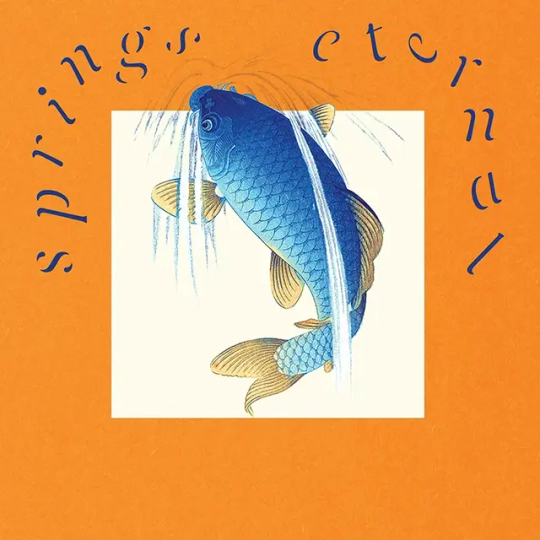
19. Daniel Blumberg ‘The Brutalist’ OST

18. Doechii ‘Alligator Bites Never Heal’
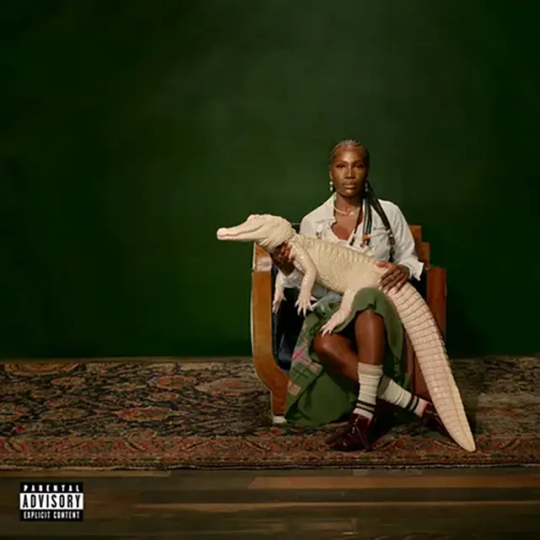
17. Julia Holter ‘Something In The Room She Moves’

16. Good Sad Happy Bad ‘All Kinds Of Days’

15. Astrid Sonne ‘Great Doubt’

14. Claire Rousay ‘Sentiment’

13. Cindy Lee ‘Diamond Jubilee’

12. Clairo ‘Charm’

11. Trust Fund ‘Has It Been A While?’

10. Mermaid Chunky ‘Slif Slaf Slof’

9. The Lemon Twigs ‘A Dream Is All We Know’

8. Kendrick Lamar ‘GNX’

7. Geordie Greep ‘The New Sound’
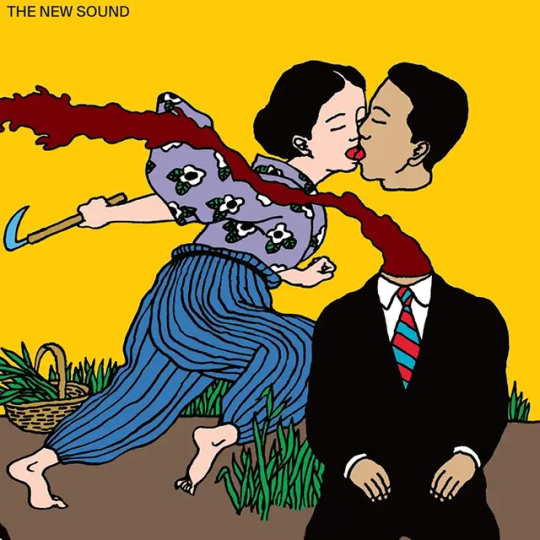
6. Mount Kimbie ‘The Sunset Violent’
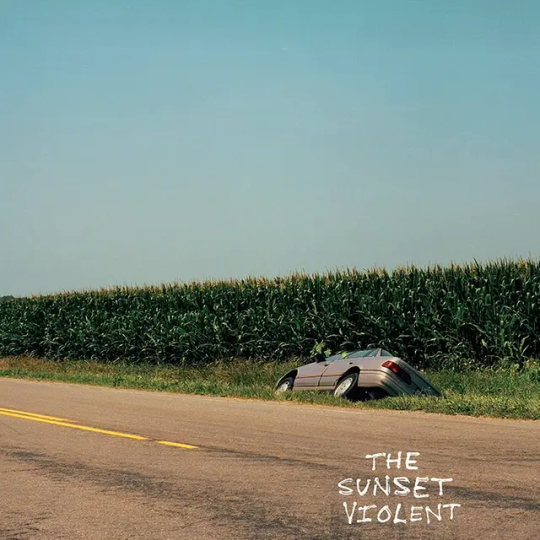
5. JPEGMAFIA ‘I Lay Down My Life For You’

4. A.G. Cook ‘Britpop’

3. Magdalena Bay ‘Imaginal Disk’

2. Charli XCX ‘Brat’ (+ ‘Brat And It’s Completely Different But Also Still Brat’)

1. Vampire Weekend ‘Only God Was Above Us’

1 note
·
View note
Text
Evanston Folk Fest Saturday: 9/7, Dawes Park

Sierra Ferrell
BY JORDAN MAINZER
Every musician I watched on Saturday at the Evanston Folk Fest grappled with, directly or indirectly, what folk music means in 2024. I knew going in, given the prestige of the musical lineup and speakers in the interview tent, that the festival would not be one that casts off "folk" as a mere aesthetic, visual or instrumental. Indeed, even if many of the booked musicians didn't fit the general schema of the folk genre, they abided by its most important tenet: music not just by the people but for the people, independent of level of expertise.
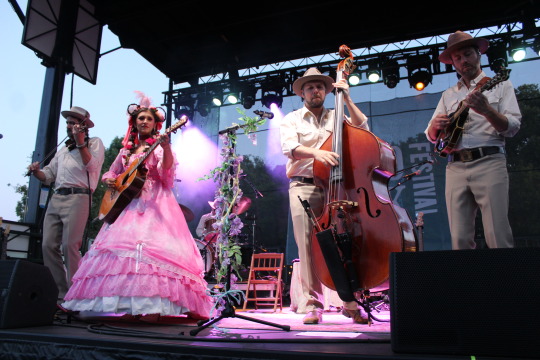
From left to right: Oliver Bates Craven, Ferrell, Matty Meyer, Geoff Saunders, & Joshua Rilko
Headlining the night was Sierra Ferrell, a singer-songwriter from West Virginia whose unique mix of bluegrass and Latin-influenced arrangements (and, yes, wild outfits) have allowed her to garner steadily increasing crossover appeal beyond her initial viral rise. Earlier this year, she released her fourth studio album Trail of Flowers (Rounder), which managed to widen the spectrum of her sound while emphasizing--let alone not losing--her idiosyncrasies. On standout fiddle jam "I Could Drive You Crazy"--Ferrell's proclaimed greatest relationship skill--you can hear crowd chatter from a show she did on a previous New Year's Eve. Such noise was almost perfectly replicated on Saturday, as Ferrell's band (multi-instrumentalist Oliver Bates Craven, mandolinist Joshua Rilko, bassist Geoff Saunders, drummer Matty Meyer) led off with the song's melody to welcome her onto the stage. As she waltzed on, revealing her poofy pink dress and feathered-and-flowered hair, done up like an Appalachian Björk, her fans did indeed hoot and holler.

Ferrell
Likewise, no matter the studio sheen of Trail of Flowers (or "Fox Hunt" being thumping enough to soundtrack an NFL cut to commercial), live, its songs fit seamlessly into a set that seemed intimate despite the large crowd. Album opener "American Dreaming" has found a second life as a song to be played near the end of the show, a crowd singalong due to its catchy melody and commonly felt story of a person unable to sit still. For touring musician Ferrell, who started out as train-hopping, van-dwelling, busking nomad, the only difference now is she can better afford nightly lodging. When performing, her unmistakably raspy voice takes even sharper twists and turns: During "Chittlin' Cookin' Time in Cheatham County", she occupied the shrillness of Joanna Newsom, flutters of Josephine Foster, and barroom gurgle of Tom Waits from moment to moment. Later, during Kris Kristofferson's "Me and Bobby McGee", but in the style of its most famous iteration by Janis Joplin, you half-expected Ferrell to do a Joplin impression. She has the skills, but instead, she made it her own, a true folk singer who can sing a song from the collective consciousness, but not showy enough to discourage others from joining in.

Rilko

Craven, Meyer, Farrell, & Saunders
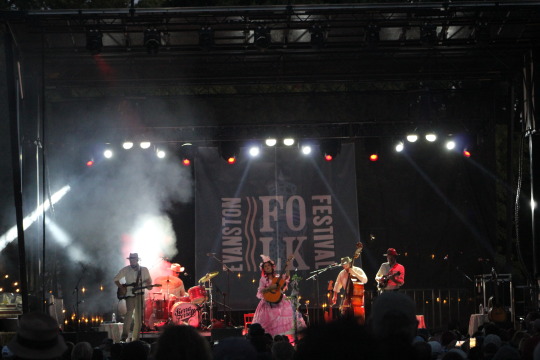
Craven, Meyer, Farrell, Saunders, & Rilko

Hiss Golden Messenger

Hiss Golden Messenger
Midway through his solo set, Hiss Golden Messenger's MC Taylor let the crowd know he was going to do a cover of a folk song. "I was a folklorist in my former life, so I feel qualified to play it," he quipped. The song was Grateful Dead's "Bertha", and it received such rapturous applause that Taylor joked he should have led off with it. First, Taylor's always qualified to play Dead songs. His venerable band has been interpolating "Franklin's Tower" into Lateness of Dancers bop "Lucia" for years, and he's beginning to release live recordings on his Bandcamp page at the pace of a certain band that was oft-bootlegged. More importantly, though, at this point, Hiss Golden Messenger has developed a catalog of contemporary folk classics. As soon as Taylor came on stage, introduced by Evanston mayor Daniel Biss, an eager crowd member requested "Sanctuary", to which a chuffed Taylor requested patience, replying, "We'll get there!" As Hiss Golden Messenger studio songs and full-band performances expand in length and sound, they always sound good stripped down, too, from newer tunes like "Shinbone" to favorites like "Biloxi". Of course, it's the biggest treat to hear songs from acoustic masterpiece Bad Debt, an album he'll play in full next month at SPACE. Taylor gave the Evanston Folk Fest crowd a preview of what's to come with "Balthazar's Song", a tune that could make you melt on the coldest day of the year.

Hiss Golden Messenger

Hiss Golden Messenger

Mayor of Evanston, Daniel Biss

Willi Carlisle
And then there was the artist who, perhaps expectedly, most reckoned with the idea of what folk music means, Arkansas-based singer-songwriter Willi Carlisle. Sure, some of it was tongue-in-cheek, asking what an upper-middle-class Chicago suburb was doing deciding what constitutes a folk festival, but for the most part, Carlisle framed folk music as being in constant battle with that which represents an existential threat to, well, regular folks: capitalism, empire, and the patriarchy. Carlisle is a captivating storyteller and musician, reciting his poetry at a breakneck pace and ad-libbing, too, switching between banjo, fiddle, guitar, and a capella. I'm glad he's released a taste of what his shows are like with Tales From Critterland (Signature Sounds), which features three of the many songs he played on Saturday, plus their proper introductions: "The Arrangements", inspired by and dedicated to his and all bad fathers, "Critterland", which came from his attempt to live in an intentional community, and Steve Goodman's "The Ballad of Penny Evans". It was that last one that was the song of the day on Saturday, perfect for time and place. Let's acknowledge the elephant in the room: Goodman's best known in Chicago for writing the song that plays at Wrigley Field after the Cubs win. The crowd at Evanston Folk Fest was likely more familiar than is the average Chicagoan with Goodman's penchant for writing incredibly moving and righteous songs, but for those who weren't, Carlisle's show-stopping version of Goodman's anti-Vietnam War ballad surely gave them the chills. On Tales From Critterland, Carlisle explains how Goodman lifted the melody from a song about slavery, sung from the point of view of the slaveowner, repurposing a great melody for a song with complete opposite levels of morality, an exercise in the evolution of songs. On Saturday, Carlisle simply dedicated his performance to all the Palestinians murdered by a despotic Israeli government. It was a moment that most spoke to folk music's true power, that of "This machine kills fascists" protest, an ability to foresee unfortunately everlasting societal ills, and a dare to hope for a better world.

Carlisle
#live music#evanston folk festival#sierra ferrell#oliver bates craven#matty meyer#hiss golden messenger#daniel biss#space#willi carlisle#signature sounds#trail of flowers#geoff saunders#joshua rilko#rounder#rounder records#joanna newsom#josephine foster#tom waits#kris kristofferson#janis joplin#mc taylor#grateful dead#lateness of dancers#bad debt#tales from critterland#signature sounds recording inc.#steve goodman#wrigley field#chicago cubs#evanston folk fest
1 note
·
View note